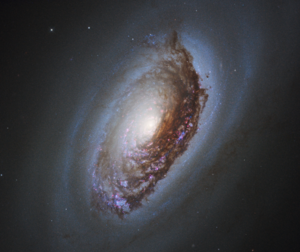Messier 64
| Galaxy Messier 64 |
|
|---|---|

|
|
| The central area of the spiral galaxy Messier 64, as seen by the Hubble Space Telescope | |
| AladinLite | |
| Constellation | Berenike's hair |
|
Position equinox : J2000.0 , epoch : J2000.0 |
|
| Right ascension | 12 h 56 m 43.6 s |
| declination | + 21 ° 40 ′ 59 ″ |
| Appearance | |
| Morphological type | (R) SA (rs) ab; HIISy2 |
| Brightness (visual) | 8.5 likes |
| Brightness (B-band) | 9.3 mag |
| Angular expansion | 10 ′, 0 × 5 ′, 4 |
| Position angle | 115 ° |
| Surface brightness | 12.7 mag / arcmin² |
| Physical data | |
| Redshift | +0.001361 ± 0.000013 |
| Radial velocity | +408 ± 4 km / s |
|
Stroke distance v rad / H 0 |
(18 ± 1) x 10 6 ly (5.48 ± 0.39) Mpc |
| history | |
| discovery |
Edward Pigott Johann Elert Bode |
| Discovery date | March 23, 1779 April 4, 1779 |
| Catalog names | |
| M 64 • NGC 4826 • UGC 8062 • PGC 44182 • CGCG 130-1 • MCG + 4-31-1 • IRAS 12542 + 2157 • GC 3321 • h 1486 • Kara 559 • Bode 77 • PKS 1254 + 21 | |
Messier 64 (also known as NGC 4826 or Blackeye galaxy ) is a spiral galaxy with dimensions 10 ′, 0 × 5 ′, 4 arc minutes and an apparent magnitude of 8.5 mag in the constellation Coma Berenices . It has a large oval dark cloud north of the core with an extension of about 8000 light years and a size of 9.2 × 4.6 arc minutes, which was probably formed by merging with a small, very dusty galaxy around a billion years ago.
This could explain the one-sided concentration of dark clouds and the many regions close to the core with unusually powerful star formation .

The galaxy, about 24 million light years away, was previously listed as a member of the Canes Venatici I group , but in more recent sources it is assigned to its own small group.
discovery
The galaxy Messier 64 was discovered in Wales on March 23, 1779 by the British astronomer Edward Pigott , who did not publish his observation until two years later. As a result, Johann Elert Bode was first seen as the discoverer, who discovered them independently of Pigott 12 days later. It was included in the Messier catalog a year later.
William Herschel was the first to notice the dark spot north of the core, which later gave the galaxy the name "Black Eye" after showing it to the British physicist Charles Blagden , who then compared it to a black eye.
Amateur community project

In the spring of 2019, a M64-joint project of Ralf Burkart-Kreuels was initiated, which had summarize the recordings of 23 amateurs objective is to obtain a similar depth and detail imaging as with large observatories or the Hubble Space Telescope (HST) is possible . All the amateurs did not know each other personally, but followed a call to the astronomy forum Astrotreff. Telescopes were used for image acquisition in Germany and Austria, which varied from 5-16 inches. The focal lengths represented were 560-6,000 mm. Various different cameras were also used. A limit size of 23–24 mag for stars and galaxies could be reached with an exposure time of 190 hours! Messier 64 was u. a. Chosen because it contains very faint molecular clouds in the diffuse outer disk that are seldom seen in other amateur images. The comparatively bright core, on the other hand, offered something for short-term exposures in order to get the maximum resolution out. In the end result after one year 513 stars, 621 galaxies, six quasars, 86 cataloged molecular clouds and 102 unclassified objects were recorded. The latter are probably other background galaxies. A comparison with the HST does not have to shy away from this recording.
Web links
Individual evidence
- ↑ a b c d NASA / IPAC EXTRAGALACTIC DATABASE
- ↑ a b c d e SEDS : NGC 4826
- ↑ Stars and Space April 2006 p. 58
- ^ RB Tully: The Local Supercluster . In: Astrophysical Journal . 257, 1982, pp. 389-422. bibcode : 1982ApJ ... 257..389T . doi : 10.1086 / 159999 .
- ↑ Seligman
- ↑ Stars and Space, May 2008, p. 86, The galaxy M64 in the constellation Haar der Berenike
- ↑ http://www.astrotreff.de/topic.asp?TOPIC_ID=236392&whichpage=1
- ↑ Ralf Kreuels: 23 amateur telescopes and one target . In: astronomie - the magazine . No. 11 . Astronomie Medien GmbH, Hamburg May 2020, p. 82 .


